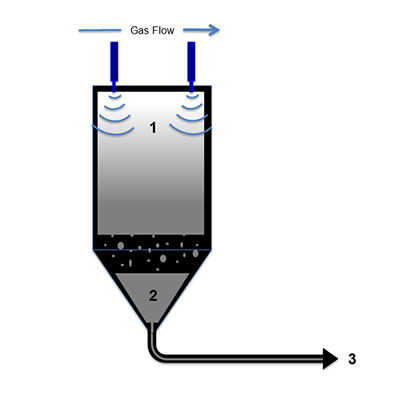Introduction to ESPs: Theory of Operations: Removal
Particulate matter that has accumulated to a certain thickness on the CE is removed by one of two processes, depending on the type of CE used. Collection electrodes in ESPs can be either plates or tubes, with plates being the more common of the two. Tubes-type ESPs are usually cleaned by water sprays, while plates can be cleaned by either water sprays or a process called rapping. We will focus on the latter.
Rapping: Dislodging Particulate Matter
Rapping is a process whereby deposited, dry particles are dislodged from the CE by sending mechanical impulses, or vibrations, to the plates. Precipitator plates are rapped periodically while maintaining the continuous flue-gas cleaning process. In other words, the plates are rapped while the ESP is on-line; the gas flow continues through the ESP and the applied voltage remains constant. Plates are rapped when the accumulated dust layer is relatively thick (0.08 to 1.27 cm) so that the dust layer is coaxed to fall off the plates as large aggregate sheets instead of small sections, helping to minimize re-entrainment. Most precipitators have adjustable rappers that allow rapper intensity and frequency to be changed according to the dust concentration in the flue gas. Precipitator fields with heavy dust concentrations require more frequent rapping than fields with light dust concentrations.
Recycle or Disposal
As PM is dislodged from CEs, is falls into the hopper. A hopper is a dedicated collection bin with sides sloping approximately 50 to 70o so that PM is allowed to flow freely from the top of the hopper to the discharge opening in the bottom. Particulate matter collected in hoppers should be removed as soon as possible in order to avoid packing that is very difficult to remove. Most hoppers are emptied by some type of discharge device and then a conveyor transports the collected PM to its final destination for recycling or disposal.
In an ESP using liquid sprays to remove accumulated PM, the sludge collects in a holding basin at the bottom of the vessel. The sludge is then sent to settling ponds of lined landfills for proper ultimate disposal. Spraying can occur while the ESP is on-line and is typically intermittent. While water is generally used as the spraying liquid in wet ESPS, other liquids could be used if absorption of gaseous pollutants is also a goal.
Helpful Resources
KnowledgeBase: Theory of Operations: Charging
KnowledgeBase: Theory of Operations: Collecting
KnowledgeBase: Rapping Systems
KnowledgeBase: Reduce ReEntrainment
KnowledgeBase: Improve Rapping Systems



